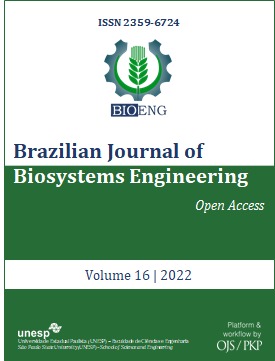Effects of coffee maturation regulators
DOI:
https://doi.org/10.18011/bioeng.2022.v16.1060Keywords:
Coffee tree, Quality, Mathury, EthyleneAbstract
The maturation of coffee fruits is a concern of coffee growers, as it directly influences the efficiency of the harvest and can interfere with the quality of the product. Therefore, the use of maturation regulators that act by controlling the speed of maturation are being increasingly used. As such, the objective of this work was to evaluate the effects of the regulators Ethrel® and MathuryTM, in 4 treatments composed by the control, application of Ethrel®, application of MathuryTM, application of the combination of Ethrel® followed by the application of MathuryTM. Thus, the maturation stage of the fruits, the type, and the final grade regarding the quality of the drink were evaluated. After that, the data of the evaluated characteristics were submitted to statistical analysis by the Scott-Knott test at 5% probability. The maturation regulators used in this experiment did not interfere with the quality of the product and the classification of the coffee. However, treatments with application of Ethrel® alone or combined with MathuryTM provided anticipation and uniformity of coffee fruits.
Downloads
References
BRASIL, Ministério da Agricultura, Pecuária e Abastecimento. (2003). Instrução Normativa n. 8. Regulamento Técnico de Identidade e de Qualidade para a Classificação do Café Beneficiado Grão Cru. Brasília. Available in: http://sistemasweb.agricultura.gov.br/sislegis/ action/detalhaAto.do?method=consultarLegislacaoFederal
Cabrera, L. C; Caldarelli, C. E. (2020). Estudo bibliométrico sobre a pesquisa científica de cafés certificados na web of Science. Reuna, Belo Horizonte - MG, Brasil, 25 (2), 1-19. http://dx.doi.org/10.21714/2179-8834/2020v25n2p1-19
Carvalho, G. R.; Mendes, A. N. G.; Carvalho, L. F.; Bartholo, G. F. (2013). Eficiência do ethephon na uniformização e antecipação da maturação de frutos de cafeeiro (Coffea arabica L.) e na qualidade da bebida. Ciênc. Agrotec, Lavras, Minas Gerais, 27 (1), 98-106. https://doi.org/10.1590/S1413-70542003000100012
Ferreira, D. F. Sisvar: um guia dos seus procedimentos de comparações múltiplas Bootstrap (2014). Ciência e Agrotecnologia, 38 (2), 109-112. https://doi.org/10.1590/S1413-70542014000200001
Goes, T. B.; Chinelato, G. A. (2018). Viabilidade econômico-financeira da cultura do café arábica na região da Alta Mogiana Viabilidade econômico-financeira da cultura do café arábica na região da Alta Mogiana. Revista IPecege, Piracicaba, São Paulo, 4 (4), 31-39. https://doi.org/10.22167/r.ipecege.2018.4.31
Matiello, J. B.; Almeida, S.; Garcia, A. W. R.; Santinato, R. (2015). Cultura de café no Brasil: Manual de recomendações (15ª ed.).
Negreiros, V. M. V; Nascentes, R. F; Nascentes; M. C. B; (2019). Efeitos da aplicação de regulador vegetal na maturação e na qualidade de bebida dos frutos do café. Revista Agrofib, Bauru, São Paulo, 1(1), 13-25. Available in: https://revistas.fibbauru.br/agrofib/article/view/378
Rodrigues, J. D.; Ono, E. O. (2014). Na hora certa. Cultivar, São Paulo, 30(3), p.32-34. Available in: http://www.grupocultivar.com.br/ativemanager/unploads/arquivos/artigos/gc30_cafe.pdf
Santinato, F.; Tavares, T. O.; Silva, R. P.; Silva, C. D.; Ormond, A. T. S. (2017). Estratégias para uniformização da maturação de frutos do cafeeiro. Revista Agrarian, Jaboticabal, São Paulo, 10 (38), 321-327. https://doi.org/10.30612/agrarian.v10i38.4448
Specialty coffee association of america (SCAA). (2021). SCAA Cupping Protocols. Available in: http://coffeetraveler.net/wp-content/files/901-SCAA_CuppingProtocols_TSC_DocV_RevDec08_Portuguese.pdf
Downloads
Published
How to Cite
Issue
Section
License
Copyright (c) 2022 Revista Brasileira de Engenharia de Biossistemas

This work is licensed under a Creative Commons Attribution 4.0 International License.
Authors who publish in this journal agree to the following terms:
a) Authors retain the copyright and grant the journal the right of first publication, with the work simultaneously licensed under the Creative Commons Attribution License that allows the sharing of the work with recognition of authorship and initial publication in this journal.
b) Authors are authorized to assume additional contracts separately, for non-exclusive distribution of the version of the work published in this journal (eg, publish in an institutional repository or as a book chapter), with recognition of authorship and initial publication in this journal.













